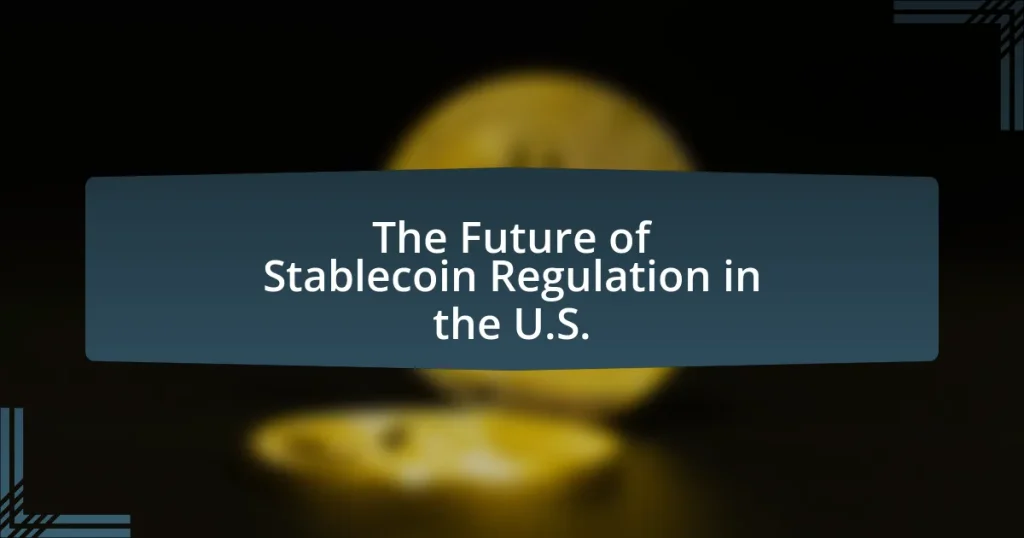The article focuses on the future of stablecoin regulation in the United States, highlighting the need for comprehensive frameworks that address consumer protection, financial stability, and anti-money laundering measures. It discusses the evolving regulatory landscape, including the roles of key agencies such as the U.S. Treasury, the Federal Reserve, and the SEC, as well as the implications of stablecoin adoption, which has surpassed a market capitalization of $150 billion. The article outlines the definition of stablecoins, their unique characteristics compared to other cryptocurrencies, and the risks posed by unregulated stablecoins. It also examines current regulatory frameworks, potential legislative changes, and best practices for effective regulation, emphasizing the importance of collaboration between regulators and industry stakeholders to enhance consumer trust and market integrity.

What is the Future of Stablecoin Regulation in the U.S.?
The future of stablecoin regulation in the U.S. is likely to involve comprehensive frameworks that address consumer protection, financial stability, and anti-money laundering measures. Recent discussions among regulators, including the U.S. Treasury and the Federal Reserve, indicate a push for clearer guidelines that would categorize stablecoins as a form of payment and potentially subject them to banking regulations. The Biden administration’s report on stablecoins emphasizes the need for legislative action to mitigate risks associated with their use, suggesting that Congress may introduce new laws to govern their issuance and management. This regulatory evolution is driven by the increasing adoption of stablecoins, which reached a market capitalization exceeding $150 billion in 2023, highlighting the urgency for a structured approach to ensure market integrity and consumer safety.
How is stablecoin defined within the context of U.S. regulation?
Stablecoin is defined within the context of U.S. regulation as a type of digital asset that is pegged to a stable reserve, such as a fiat currency or commodity, to maintain a stable value. This definition is influenced by various regulatory bodies, including the Financial Crimes Enforcement Network (FinCEN) and the Securities and Exchange Commission (SEC), which assess stablecoins based on their underlying assets and the mechanisms used to maintain their value. For instance, the SEC has indicated that certain stablecoins may be classified as securities if they meet the criteria outlined in the Howey Test, which evaluates investment contracts based on the expectation of profits derived from the efforts of others.
What are the key characteristics that differentiate stablecoins from other cryptocurrencies?
Stablecoins are primarily differentiated from other cryptocurrencies by their price stability, which is typically achieved through pegging to a reserve asset, such as fiat currency or commodities. This peg allows stablecoins to maintain a consistent value, unlike volatile cryptocurrencies like Bitcoin or Ethereum, which can experience significant price fluctuations. For example, Tether (USDT) is pegged to the U.S. dollar, ensuring that one USDT is intended to equal one dollar, providing users with a reliable medium of exchange and store of value. Additionally, stablecoins often incorporate mechanisms for collateralization or algorithmic adjustments to maintain their peg, further distinguishing them from traditional cryptocurrencies that lack such stability features.
How do stablecoins function in the financial ecosystem?
Stablecoins function in the financial ecosystem by providing a stable digital currency that is pegged to a reserve asset, typically a fiat currency like the U.S. dollar. This pegging mechanism allows stablecoins to maintain a consistent value, making them suitable for transactions, remittances, and as a store of value in the volatile cryptocurrency market. For instance, Tether (USDT) and USD Coin (USDC) are examples of stablecoins that are backed by reserves, ensuring that each coin can be redeemed for a specific amount of fiat currency. This stability facilitates their use in decentralized finance (DeFi) applications, where users can lend, borrow, and trade without the risk of price fluctuations commonly associated with other cryptocurrencies.
Why is stablecoin regulation important for the U.S. economy?
Stablecoin regulation is important for the U.S. economy because it ensures financial stability and consumer protection. By establishing clear guidelines, regulators can mitigate risks associated with volatility, fraud, and systemic failures that could arise from unregulated stablecoin activities. For instance, the rapid growth of stablecoins, which reached a market capitalization of over $150 billion in 2021, poses challenges to monetary policy and financial stability if left unchecked. Regulation can help integrate stablecoins into the broader financial system, fostering innovation while safeguarding against potential economic disruptions.
What risks do unregulated stablecoins pose to financial stability?
Unregulated stablecoins pose significant risks to financial stability by potentially leading to systemic risks, market volatility, and loss of consumer confidence. The lack of regulatory oversight can result in inadequate backing of the stablecoins, which may cause a loss of value during market stress, as seen in the collapse of certain algorithmic stablecoins. Additionally, unregulated stablecoins can facilitate illicit activities, undermining the integrity of the financial system. The Financial Stability Oversight Council has highlighted that the rapid growth of stablecoins could create vulnerabilities in the financial system, particularly if they become widely adopted without proper safeguards.
How can regulation enhance consumer protection in the stablecoin market?
Regulation can enhance consumer protection in the stablecoin market by establishing clear guidelines for issuers, ensuring transparency, and enforcing compliance with financial standards. By requiring stablecoin issuers to maintain adequate reserves and undergo regular audits, regulators can help safeguard consumer funds and build trust in the market. For instance, the implementation of the Financial Stability Oversight Council’s recommendations could lead to more stringent oversight, reducing the risk of fraud and mismanagement. Additionally, regulations can mandate disclosures about the risks associated with stablecoins, empowering consumers to make informed decisions.
What are the current regulatory frameworks affecting stablecoins in the U.S.?
The current regulatory frameworks affecting stablecoins in the U.S. include guidance from the Financial Crimes Enforcement Network (FinCEN), the Securities and Exchange Commission (SEC), and the Commodity Futures Trading Commission (CFTC). FinCEN requires stablecoin issuers to comply with anti-money laundering (AML) and know your customer (KYC) regulations, treating them as money transmitters. The SEC has indicated that certain stablecoins may be classified as securities, depending on their structure and use, which would subject them to additional regulatory scrutiny. The CFTC has jurisdiction over derivatives involving stablecoins, emphasizing the need for compliance with commodity trading regulations. These frameworks are evolving as regulators seek to address risks associated with stablecoins, including consumer protection and financial stability.
Which government agencies are involved in the regulation of stablecoins?
The primary government agencies involved in the regulation of stablecoins in the U.S. are the Financial Stability Oversight Council (FSOC), the Commodity Futures Trading Commission (CFTC), and the Securities and Exchange Commission (SEC). The FSOC monitors systemic risks and can designate stablecoins as systemically important financial market utilities. The CFTC regulates derivatives markets and has jurisdiction over certain stablecoin-related activities, while the SEC assesses whether stablecoins qualify as securities under federal law. These agencies collaborate to ensure comprehensive oversight of the stablecoin ecosystem, addressing concerns related to consumer protection, market integrity, and financial stability.
What existing laws and regulations apply to stablecoins?
Existing laws and regulations that apply to stablecoins include the Bank Secrecy Act (BSA), which mandates anti-money laundering (AML) and know your customer (KYC) requirements for financial institutions, including those dealing with stablecoins. Additionally, the Commodity Futures Trading Commission (CFTC) classifies certain stablecoins as commodities, subjecting them to relevant regulations. The Securities and Exchange Commission (SEC) may also regulate stablecoins if they are deemed to be securities under the Howey Test. Furthermore, state-level regulations, such as those from the New York State Department of Financial Services (NYDFS), impose licensing requirements on stablecoin issuers. These frameworks collectively establish a regulatory environment for stablecoins in the U.S.
How might future regulations shape the stablecoin landscape?
Future regulations will likely enhance the stability and transparency of the stablecoin landscape. By establishing clear guidelines for issuance, reserve requirements, and consumer protections, regulators can mitigate risks associated with volatility and fraud. For instance, the proposed regulations by the U.S. Treasury aim to ensure that stablecoins are backed by sufficient reserves, which would increase trust among users and investors. Additionally, regulatory frameworks could facilitate interoperability between different stablecoins and traditional financial systems, promoting broader adoption and integration into the economy.
What potential regulatory changes are being discussed by lawmakers?
Lawmakers are discussing potential regulatory changes that would establish clearer guidelines for stablecoin issuers, focusing on consumer protection, financial stability, and anti-money laundering measures. These discussions include proposals for requiring stablecoin issuers to maintain sufficient reserves, undergo regular audits, and register with regulatory bodies to ensure compliance with existing financial regulations. Additionally, there is consideration of creating a federal framework to oversee stablecoin operations, which aims to mitigate risks associated with the rapid growth of digital currencies and enhance market transparency.
How could these changes impact the adoption of stablecoins?
Changes in stablecoin regulation could significantly enhance the adoption of stablecoins by providing clearer guidelines and increased consumer confidence. For instance, regulatory clarity can reduce the perceived risks associated with stablecoins, encouraging both individuals and institutions to utilize them for transactions and investments. According to a report by the Blockchain Association, 70% of cryptocurrency users express a preference for regulated products, indicating that regulatory frameworks could lead to broader acceptance and usage of stablecoins in everyday financial activities.
What challenges do regulators face in overseeing stablecoins?
Regulators face significant challenges in overseeing stablecoins, primarily due to their decentralized nature and the lack of a unified regulatory framework. The rapid growth of stablecoins, which can operate across borders and outside traditional banking systems, complicates enforcement and compliance efforts. Additionally, the diverse types of stablecoins, such as fiat-collateralized, crypto-collateralized, and algorithmic stablecoins, create difficulties in applying consistent regulatory standards. The potential for financial instability, consumer protection issues, and the risk of illicit activities further complicate the regulatory landscape, as evidenced by the increasing scrutiny from agencies like the Financial Stability Oversight Council and the need for comprehensive legislation to address these concerns.
How do technological advancements complicate stablecoin regulation?
Technological advancements complicate stablecoin regulation by introducing rapid innovation that outpaces existing regulatory frameworks. The decentralized nature of blockchain technology allows for peer-to-peer transactions without intermediaries, making it difficult for regulators to enforce compliance and monitor transactions effectively. Additionally, the use of smart contracts and decentralized finance (DeFi) platforms creates complex ecosystems that challenge traditional regulatory approaches, as these systems can operate globally and autonomously. This complexity is evidenced by the increasing number of stablecoins and their diverse underlying mechanisms, which further complicate the establishment of uniform regulatory standards.
What are the differing perspectives among stakeholders regarding regulation?
Stakeholders regarding stablecoin regulation have differing perspectives primarily based on their interests and roles in the financial ecosystem. Financial institutions often advocate for stringent regulations to ensure consumer protection and market stability, citing concerns about potential risks associated with unregulated stablecoins. Conversely, technology firms and cryptocurrency advocates typically argue for a more flexible regulatory approach, emphasizing innovation and the need for a supportive environment that fosters growth in the digital asset space. Additionally, policymakers may express a desire for balanced regulations that protect consumers while not stifling technological advancement, reflecting the complexities of integrating stablecoins into the existing financial framework. These varying viewpoints highlight the ongoing debate about how best to regulate stablecoins in a way that addresses risks without hindering innovation.
What best practices can be adopted for effective stablecoin regulation?
Effective stablecoin regulation can be achieved through a combination of clear legal frameworks, robust consumer protection measures, and ongoing collaboration between regulators and industry stakeholders. Establishing a clear legal framework ensures that stablecoins are classified appropriately, which can help mitigate risks associated with their use. Implementing consumer protection measures, such as transparency requirements regarding reserves and risks, can safeguard users and enhance trust in stablecoin systems. Additionally, fostering collaboration between regulators and industry participants can lead to more informed and adaptive regulatory approaches, as seen in the European Union’s MiCA regulation, which aims to create a comprehensive regulatory environment for crypto-assets.
How can collaboration between regulators and industry stakeholders improve outcomes?
Collaboration between regulators and industry stakeholders can improve outcomes by fostering a shared understanding of risks and opportunities, leading to more effective regulatory frameworks. When regulators engage with industry representatives, they gain insights into market dynamics and technological advancements, which can inform policies that are both protective and conducive to innovation. For example, the Financial Stability Oversight Council (FSOC) has emphasized the importance of public-private partnerships in addressing the complexities of digital assets, highlighting that such collaboration can enhance regulatory clarity and compliance. This approach not only mitigates risks associated with stablecoins but also encourages responsible growth within the sector, ultimately benefiting consumers and the broader financial system.
What lessons can be learned from international stablecoin regulatory approaches?
International stablecoin regulatory approaches highlight the importance of comprehensive frameworks that balance innovation with consumer protection. Countries like the European Union have implemented the Markets in Crypto-Assets Regulation, which emphasizes transparency and accountability for stablecoin issuers. This approach demonstrates that clear regulatory guidelines can foster trust and stability in the market. Additionally, jurisdictions such as Singapore have adopted a risk-based regulatory framework, allowing for flexibility while ensuring that financial stability is prioritized. These examples illustrate that effective regulation can mitigate risks associated with stablecoins, such as market volatility and systemic risk, while promoting responsible growth in the sector.
What are the implications of stablecoin regulation for consumers and businesses?
Stablecoin regulation significantly impacts consumers and businesses by enhancing financial stability and consumer protection. For consumers, regulations can provide safeguards against fraud and ensure that stablecoins are backed by sufficient reserves, thereby increasing trust in these digital assets. For businesses, clear regulatory frameworks can facilitate compliance, reduce legal uncertainties, and promote innovation in financial services. According to a report by the Financial Stability Oversight Council, effective regulation can mitigate risks associated with stablecoins, such as market volatility and systemic risks, ultimately fostering a safer environment for both consumers and businesses in the digital economy.
How will regulation affect the usability of stablecoins for everyday transactions?
Regulation will enhance the usability of stablecoins for everyday transactions by providing a framework that ensures consumer protection and financial stability. Clear regulatory guidelines will foster trust among users, encouraging wider adoption and integration of stablecoins into payment systems. For instance, regulations that require stablecoin issuers to maintain adequate reserves can mitigate risks associated with volatility, making stablecoins more reliable for transactions. Additionally, compliance with anti-money laundering (AML) and know your customer (KYC) regulations will facilitate smoother transactions and reduce fraud, further promoting their use in daily commerce.
What should consumers know about the risks and benefits of regulated stablecoins?
Consumers should know that regulated stablecoins offer benefits such as price stability and easier access to digital assets, while also posing risks including regulatory uncertainty and potential loss of funds. Regulated stablecoins are designed to maintain a stable value, often pegged to fiat currencies, which can facilitate transactions and reduce volatility compared to other cryptocurrencies. However, the regulatory landscape is still evolving, and consumers may face risks related to the solvency of the issuing entities and the adequacy of consumer protections. For instance, the collapse of certain stablecoin issuers in the past has highlighted vulnerabilities in the market, emphasizing the importance of understanding the backing assets and regulatory compliance of these stablecoins.










